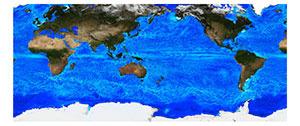OSIW: Oceanic Sub-mesoscales and Internal gravity Waves: an issue for SWOT
Author:
Patrice Klein - (LOS - IFREMER)
Co-Investigator(s):
Pascal Rivière (LEMAR, IUEM)
Lia Siegelman (LEMAR, IUEM)
Bertrand Chapron (LOPS)
Clément Ubelmann (C.L.S.)
Andrew Thompson (Caltech)
Lee-Lueng Fu (JPL)
Abstract:
The new generation of wide-swath satellite altimeters such as SWOT (CNES-NASA) will provide high-resolution SSH observations that resolve structures as small as 10 km, an order of magnitude improvement over the conventional altimeters. Within this context, a new realistic numerical simulation of the global ocean has been performed at JPL (NASA) with a 1/48° horizontal resolution and internal tides included. First results indicate, in the 10-100 km band, an unexpected regional dependency of the emergence of sub-mesoscales as well as a puzzling impact of internal waves on SSH. Such a unique global simulation can help to define and assess strategies of the analysis of SWOT observations (including through reconstruction methods) and the synergy of their use with other data. But a preliminary step is to test the robustness of this simulation with in-situ and satellite observations, in particular those available in the 10-100 km range in different parts of the World Ocean. Validation of this simulation is the purpose of our project. Comparison between simulation results and in-situ and satellite observations will concern two specific points :
- the mechanisms that produce sub-mesoscale features;
- the impact of internal waves on the SSH spectrum.
This comparison will allow us to assess with more confidence, using this validated simulation, when and in which regions SWOT observations can be used to retrieve balanced motions. It should also stimulate future fundamental studies to better understand the mechanisms involved in this 10-100 km range.
This project is part of an international effort and will be carried out within the context of the new international Working Group on High-Resolution Models (WG) created during the last SWOT Science Team meeting (June 2016). It first focuses on the Southern Hemisphere using a unique in-situ dataset at high-resolution. Another OSTST project (submitted to NASA-ROSES and led by Andy Thompson) mostly focuses on the Northern Hemisphere using the same strategy. We will then take advantage of the results from a separate study that analyses a new satellite dataset covering the World Ocean. This dataset, involving AlitKa and Sentinel-3 altimeter data, displays some impact of internal waves on SSH (Clément Ubelmann personal communication). Strategy of our project should motivate other modelling teams involved in the WG to use a similar approach to improve the physics of the different models (in terms of parameterizations and including more dynamics such as internal tides, …).

